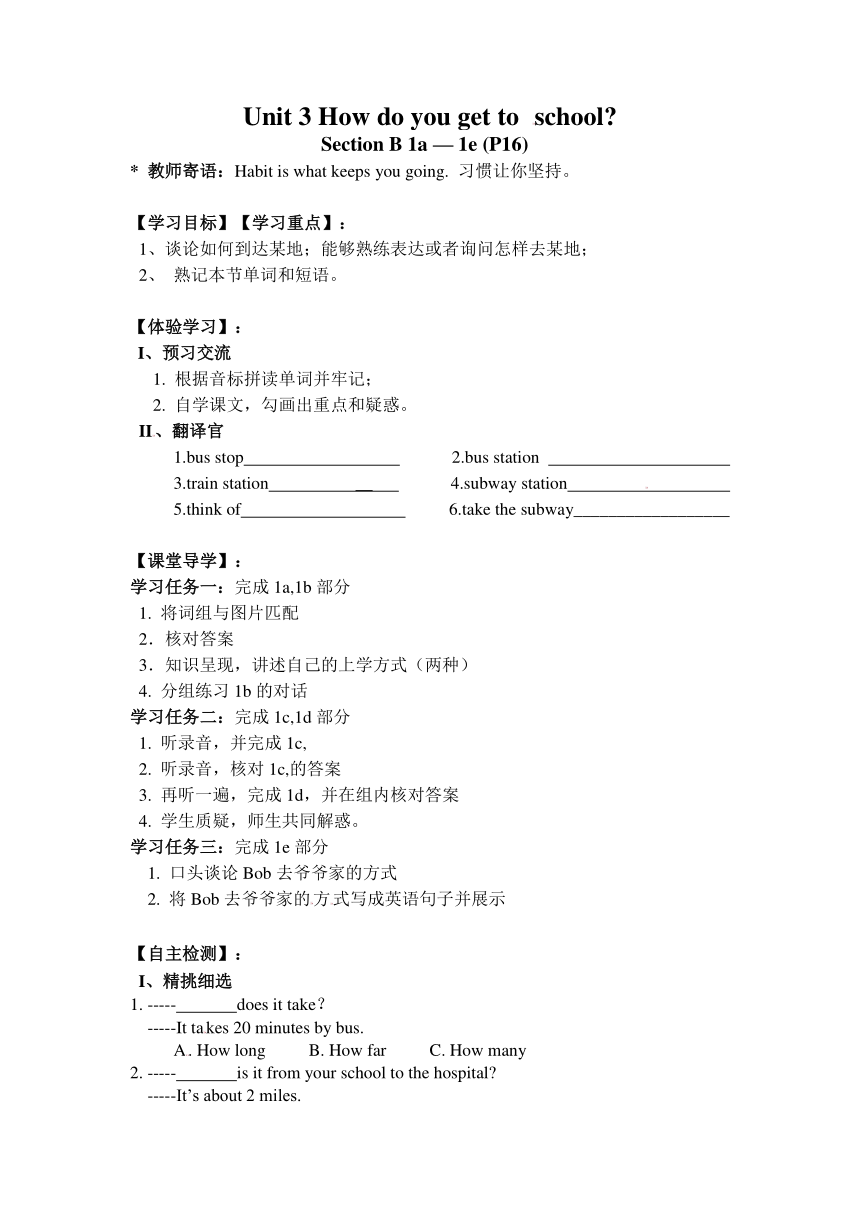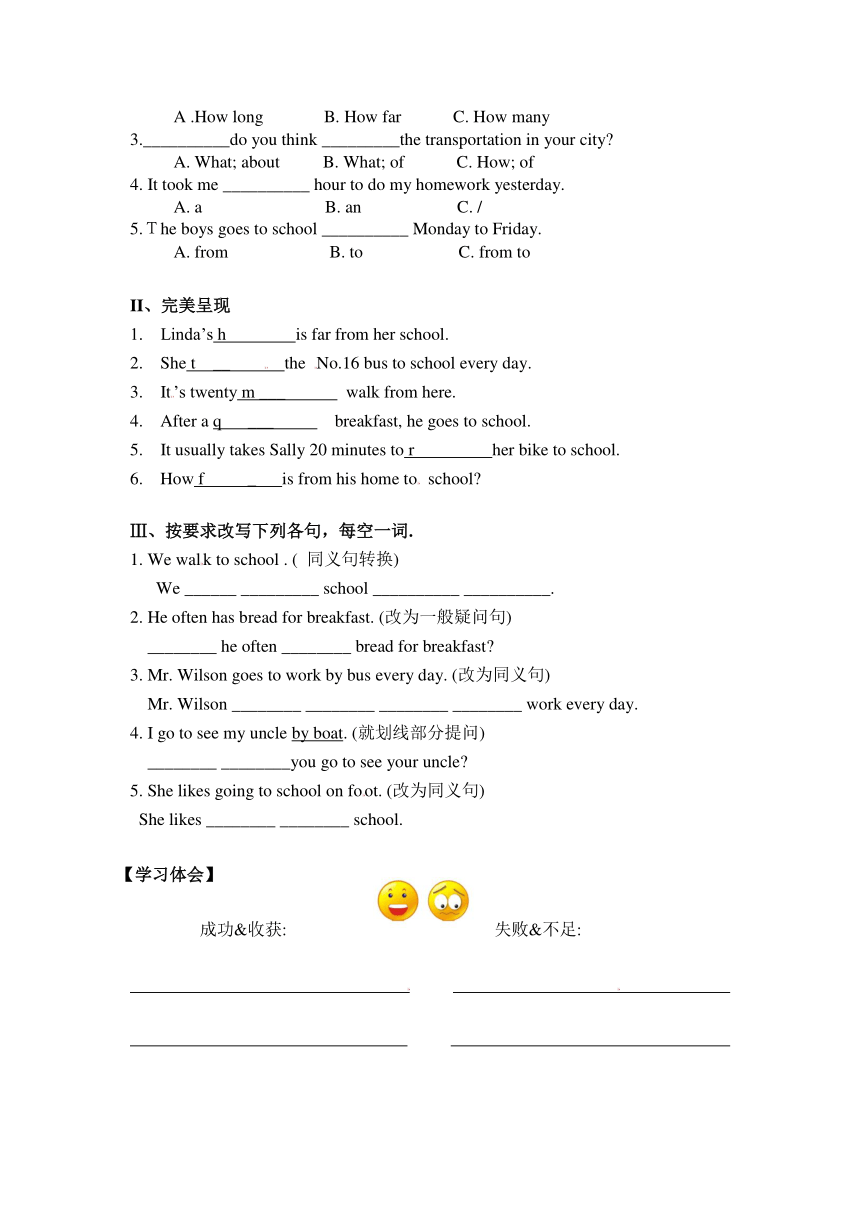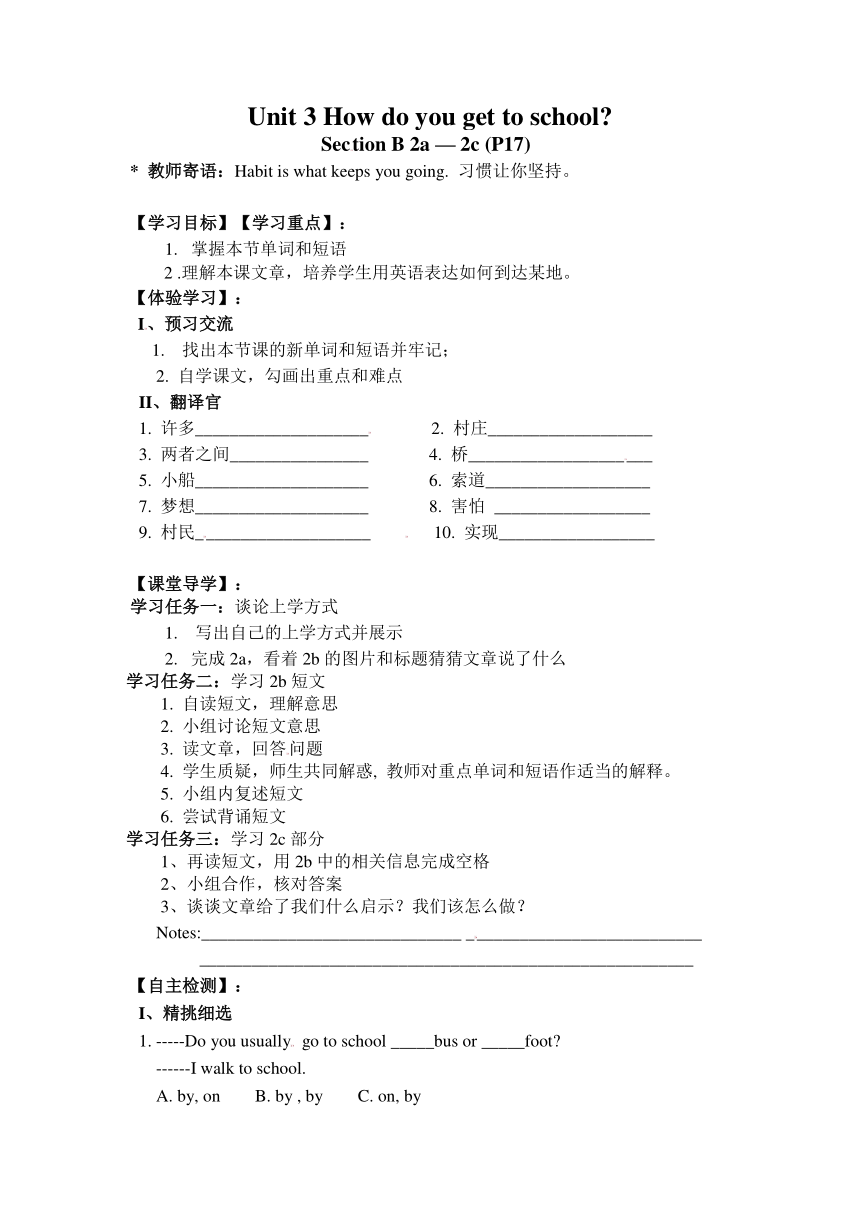Unit 3 How do you get to school?Section B 1a-selfcheck导学案(3课时)
文档属性
| 名称 | Unit 3 How do you get to school?Section B 1a-selfcheck导学案(3课时) |  | |
| 格式 | zip | ||
| 文件大小 | 53.5KB | ||
| 资源类型 | 教案 | ||
| 版本资源 | 人教新目标(Go for it)版 | ||
| 科目 | 英语 | ||
| 更新时间 | 2014-02-05 18:41:58 | ||
图片预览



文档简介
Unit 3 How do you get to school
Section B 1a — 1e (P16)
* 教师寄语:Habit is what keeps you going. 习惯让你坚持。
【学习目标】【学习重点】:
1、谈论如何到达某地;能够熟练表达或者询问怎样去某地;
2、 熟记本节单词和短语。
【体验学习】:
I、预习交流
1. 根据音标拼读单词并牢记;
2. 自学课文,勾画出重点和疑惑。
II、翻译官
1.bus stop 2.bus station
3.train station __ 4.subway station
5.think of 6.take the subway__________________
【课堂导学】:
学习任务一:完成1a,1b部分
1. 将词组与图片匹配
2.核对答案
3.知识呈现,讲述自己的上学方式(两种)
4. 分组练习1b的对话
学习任务二:完成1c,1d部分
1. 听录音,并完成1c,
2. 听录音,核对1c,的答案
3. 再听一遍,完成1d,并在组内核对答案
4. 学生质疑,师生共同解惑。
学习任务三:完成1e部分
1. 口头谈论Bob去爷爷家的方式
2. 将Bob去爷爷家的方式写成英语句子并展示
【自主检测】:
I、精挑细选
1. ----- does it take?
-----It takes 20 minutes by bus.
A. How long B. How far C. How many
2. ----- is it from your school to the hospital
-----It’s about 2 miles.
A .How long B. How far C. How many
3.__________do you think _________the transportation in your city
A. What; about B. What; of C. How; of
4. It took me __________ hour to do my homework yesterday.
A. a B. an C. /
5.The boys goes to school __________ Monday to Friday.
A. from B. to C. from to
II、完美呈现
1. Linda’s h is far from her school.
2. She t __ the No.16 bus to school every day.
3. It’s twenty m ___ walk from here.
4. After a q ___ breakfast, he goes to school.
5. It usually takes Sally 20 minutes to r her bike to school.
6. How f _ is from his home to school
Ⅲ、按要求改写下列各句,每空一词.
1. We walk to school . ( 同义句转换)
We ______ _________ school __________ __________.
2. He often has bread for breakfast. (改为一般疑问句)
________ he often ________ bread for breakfast
3. Mr. Wilson goes to work by bus every day. (改为同义句)
Mr. Wilson ________ ________ ________ ________ work every day.
4. I go to see my uncle by boat. (就划线部分提问)
________ ________you go to see your uncle
5. She likes going to school on foot. (改为同义句)
She likes ________ ________ school.
【学习体会】
成功&收获: 失败&不足:
Unit 3 How do you get to school
Section B 2a — 2c (P17)
* 教师寄语:Habit is what keeps you going. 习惯让你坚持。
【学习目标】【学习重点】:
掌握本节单词和短语
2 .理解本课文章,培养学生用英语表达如何到达某地。
【体验学习】:
I、预习交流
1. 找出本节课的新单词和短语并牢记;
2. 自学课文,勾画出重点和难点
II、翻译官
1. 许多____________________ 2. 村庄___________________
3. 两者之间________________ 4. 桥_____________________
5. 小船____________________ 6. 索道___________________
7. 梦想____________________ 8. 害怕 __________________
9. 村民____________________ 10. 实现__________________
【课堂导学】:
学习任务一:谈论上学方式
1. 写出自己的上学方式并展示
完成2a,看着2b的图片和标题猜猜文章说了什么
学习任务二:学习2b短文
1. 自读短文,理解意思
2. 小组讨论短文意思
3. 读文章,回答问题
4. 学生质疑,师生共同解惑, 教师对重点单词和短语作适当的解释。
5. 小组内复述短文
6. 尝试背诵短文
学习任务三:学习2c部分
1、再读短文,用2b中的相关信息完成空格
2、小组合作,核对答案
3、谈谈文章给了我们什么启示?我们该怎么做?
Notes:______________________________ ___________________________
_________________________________________________________
【自主检测】:
I、精挑细选
1. -----Do you usually go to school _____bus or _____foot
------I walk to school.
A. by, on B. by , by C. on, by
2. The students in the village ______ the river to school.
A. pass B. past C. cross
3. It takes them two hours ______ football very day.
A. play B. to play C. plays
4. I’m sure your dream will _______true.
A. come B. go C. leave
5. ----- What do you _____the trip
----- It’s interesting.
A. think of B. look like C. look at
II、改错:下列各句都有一处错误,请找出并在横线上改正。
My teacher want to know where I live.
_________________________________________________________
How long is it from here to your home
_________________________________________________________
Tom usually with us goes to school by the bike.
_________________________________________________________
The boy lives near the school. He often walks to there.
_________________________________________________________
This is easy for him to ride a bike.
_________________________________________________________
III.写作: 根据所给的交通工具,写一段话,介绍Lucy是怎么上学。
家—>步行—>公共汽车站—>地铁站—>步行—>学校
5minutes--10minutes--15minutes--5minutes
_________________________________________________________________________________________________________________________________________________________________________________________________________________________________________________________________________________________________________________________________________________________
【学习体会】
成功&收获: 失败&不足:
Unit 3 How do you get to school
Section B 3a — Self Check (P18)
* 教师寄语:Habit is what keeps you going. 习惯让你坚持。
【学习目标】【学习重点】:
1. 复习掌握本单元的单词及短语。
2. 熟练运用本单元句型:
3. 了解和掌握相应的语音知识。
4. 学会写电子邮件
【体验学习】:
翻译以下短语
1.到达 2.多远 _ 3.乘地铁 ____
4.过河 5.骑自行车 __ 6.考虑
7.步行 8.在…和…之间 __ 9.实现
【课堂导学】:
学习任务一:熟悉掌握本单元单词和短语。
1、自读并记忆单词5分钟。
2、组内练习,运用本单元的句型相互提问。
学习任务二:完成3a部分。
1.自读3a,理解每个句子的意思
2.小组讨论, 用所给的词填空.
3.学生质疑,师生共同解惑.
4,讨论电子邮件的写法
学习任务三:完成3b部分。
根据所给的提示,谢一封电子邮件给Tom
学习任务四:完成Self Check部分。
1完成活动1,根据所给的单词尽可能多的写出短语
2完成活动2,根据所给的提示写出5个以上的问句
3. 回答所写的问句,然后与同伴练习
学习任务五:了解和掌握相应的语音知识。
要求学生翻到教材104页,边听边跟读。
【自主检测】:
I、精挑细选
1. Mr. Wang is leaving ________ Guangzhou next week.
A. to B. with C. for
2. ----________ is it from your home to school
----- Three miles.
A. How far B. How much C. How long
3. It will take the men half a year ________ the work.
A. finish B. finishing C. to finish
4. I often go to work ________.
A. ride my bike B. by bike C. by a bike
5. Please wait for the bus at the .
A. train station B. bus station C. subway station
II. 完形填空
Getting to places can sometimes be difficult ,especially(特别) when you are going to a place for the ___1____ time.
In big cities, many people take buses, trains or subways to get from ____2____to another. Buses are a popular___3_ of transportation. If you are using a bus, you need to know___4___ bus to take and where you can get on. You ____5___ need to be able to (能够) read the timetable, so you can take the right bus and ____6___ your place on time. At last, you need to know ___7___ to get off and ___8___ the driver the name of the station.
In the countryside, transportation can be much simpler (更简单的). In some places, people get to school or work___9___ boat. Some children ride in long boats on the river to get to school. In ___10___places, students walk to the school.
1. A. first B. second C. third
2. A .one place B. the place C. places
3. A. mean B. ways C. means
4. A. what B. where C. which
5. A. too B. as well C. also
6. A. get to B. arrive C. get
7. A. why B. where C. when
8. A. say B. tell C. speak
9. A. on B. in C. by
10. A. other B. others C. else
【学习体会】
成功&收获: 失败&不足:
Section B 1a — 1e (P16)
* 教师寄语:Habit is what keeps you going. 习惯让你坚持。
【学习目标】【学习重点】:
1、谈论如何到达某地;能够熟练表达或者询问怎样去某地;
2、 熟记本节单词和短语。
【体验学习】:
I、预习交流
1. 根据音标拼读单词并牢记;
2. 自学课文,勾画出重点和疑惑。
II、翻译官
1.bus stop 2.bus station
3.train station __ 4.subway station
5.think of 6.take the subway__________________
【课堂导学】:
学习任务一:完成1a,1b部分
1. 将词组与图片匹配
2.核对答案
3.知识呈现,讲述自己的上学方式(两种)
4. 分组练习1b的对话
学习任务二:完成1c,1d部分
1. 听录音,并完成1c,
2. 听录音,核对1c,的答案
3. 再听一遍,完成1d,并在组内核对答案
4. 学生质疑,师生共同解惑。
学习任务三:完成1e部分
1. 口头谈论Bob去爷爷家的方式
2. 将Bob去爷爷家的方式写成英语句子并展示
【自主检测】:
I、精挑细选
1. ----- does it take?
-----It takes 20 minutes by bus.
A. How long B. How far C. How many
2. ----- is it from your school to the hospital
-----It’s about 2 miles.
A .How long B. How far C. How many
3.__________do you think _________the transportation in your city
A. What; about B. What; of C. How; of
4. It took me __________ hour to do my homework yesterday.
A. a B. an C. /
5.The boys goes to school __________ Monday to Friday.
A. from B. to C. from to
II、完美呈现
1. Linda’s h is far from her school.
2. She t __ the No.16 bus to school every day.
3. It’s twenty m ___ walk from here.
4. After a q ___ breakfast, he goes to school.
5. It usually takes Sally 20 minutes to r her bike to school.
6. How f _ is from his home to school
Ⅲ、按要求改写下列各句,每空一词.
1. We walk to school . ( 同义句转换)
We ______ _________ school __________ __________.
2. He often has bread for breakfast. (改为一般疑问句)
________ he often ________ bread for breakfast
3. Mr. Wilson goes to work by bus every day. (改为同义句)
Mr. Wilson ________ ________ ________ ________ work every day.
4. I go to see my uncle by boat. (就划线部分提问)
________ ________you go to see your uncle
5. She likes going to school on foot. (改为同义句)
She likes ________ ________ school.
【学习体会】
成功&收获: 失败&不足:
Unit 3 How do you get to school
Section B 2a — 2c (P17)
* 教师寄语:Habit is what keeps you going. 习惯让你坚持。
【学习目标】【学习重点】:
掌握本节单词和短语
2 .理解本课文章,培养学生用英语表达如何到达某地。
【体验学习】:
I、预习交流
1. 找出本节课的新单词和短语并牢记;
2. 自学课文,勾画出重点和难点
II、翻译官
1. 许多____________________ 2. 村庄___________________
3. 两者之间________________ 4. 桥_____________________
5. 小船____________________ 6. 索道___________________
7. 梦想____________________ 8. 害怕 __________________
9. 村民____________________ 10. 实现__________________
【课堂导学】:
学习任务一:谈论上学方式
1. 写出自己的上学方式并展示
完成2a,看着2b的图片和标题猜猜文章说了什么
学习任务二:学习2b短文
1. 自读短文,理解意思
2. 小组讨论短文意思
3. 读文章,回答问题
4. 学生质疑,师生共同解惑, 教师对重点单词和短语作适当的解释。
5. 小组内复述短文
6. 尝试背诵短文
学习任务三:学习2c部分
1、再读短文,用2b中的相关信息完成空格
2、小组合作,核对答案
3、谈谈文章给了我们什么启示?我们该怎么做?
Notes:______________________________ ___________________________
_________________________________________________________
【自主检测】:
I、精挑细选
1. -----Do you usually go to school _____bus or _____foot
------I walk to school.
A. by, on B. by , by C. on, by
2. The students in the village ______ the river to school.
A. pass B. past C. cross
3. It takes them two hours ______ football very day.
A. play B. to play C. plays
4. I’m sure your dream will _______true.
A. come B. go C. leave
5. ----- What do you _____the trip
----- It’s interesting.
A. think of B. look like C. look at
II、改错:下列各句都有一处错误,请找出并在横线上改正。
My teacher want to know where I live.
_________________________________________________________
How long is it from here to your home
_________________________________________________________
Tom usually with us goes to school by the bike.
_________________________________________________________
The boy lives near the school. He often walks to there.
_________________________________________________________
This is easy for him to ride a bike.
_________________________________________________________
III.写作: 根据所给的交通工具,写一段话,介绍Lucy是怎么上学。
家—>步行—>公共汽车站—>地铁站—>步行—>学校
5minutes--10minutes--15minutes--5minutes
_________________________________________________________________________________________________________________________________________________________________________________________________________________________________________________________________________________________________________________________________________________________
【学习体会】
成功&收获: 失败&不足:
Unit 3 How do you get to school
Section B 3a — Self Check (P18)
* 教师寄语:Habit is what keeps you going. 习惯让你坚持。
【学习目标】【学习重点】:
1. 复习掌握本单元的单词及短语。
2. 熟练运用本单元句型:
3. 了解和掌握相应的语音知识。
4. 学会写电子邮件
【体验学习】:
翻译以下短语
1.到达 2.多远 _ 3.乘地铁 ____
4.过河 5.骑自行车 __ 6.考虑
7.步行 8.在…和…之间 __ 9.实现
【课堂导学】:
学习任务一:熟悉掌握本单元单词和短语。
1、自读并记忆单词5分钟。
2、组内练习,运用本单元的句型相互提问。
学习任务二:完成3a部分。
1.自读3a,理解每个句子的意思
2.小组讨论, 用所给的词填空.
3.学生质疑,师生共同解惑.
4,讨论电子邮件的写法
学习任务三:完成3b部分。
根据所给的提示,谢一封电子邮件给Tom
学习任务四:完成Self Check部分。
1完成活动1,根据所给的单词尽可能多的写出短语
2完成活动2,根据所给的提示写出5个以上的问句
3. 回答所写的问句,然后与同伴练习
学习任务五:了解和掌握相应的语音知识。
要求学生翻到教材104页,边听边跟读。
【自主检测】:
I、精挑细选
1. Mr. Wang is leaving ________ Guangzhou next week.
A. to B. with C. for
2. ----________ is it from your home to school
----- Three miles.
A. How far B. How much C. How long
3. It will take the men half a year ________ the work.
A. finish B. finishing C. to finish
4. I often go to work ________.
A. ride my bike B. by bike C. by a bike
5. Please wait for the bus at the .
A. train station B. bus station C. subway station
II. 完形填空
Getting to places can sometimes be difficult ,especially(特别) when you are going to a place for the ___1____ time.
In big cities, many people take buses, trains or subways to get from ____2____to another. Buses are a popular___3_ of transportation. If you are using a bus, you need to know___4___ bus to take and where you can get on. You ____5___ need to be able to (能够) read the timetable, so you can take the right bus and ____6___ your place on time. At last, you need to know ___7___ to get off and ___8___ the driver the name of the station.
In the countryside, transportation can be much simpler (更简单的). In some places, people get to school or work___9___ boat. Some children ride in long boats on the river to get to school. In ___10___places, students walk to the school.
1. A. first B. second C. third
2. A .one place B. the place C. places
3. A. mean B. ways C. means
4. A. what B. where C. which
5. A. too B. as well C. also
6. A. get to B. arrive C. get
7. A. why B. where C. when
8. A. say B. tell C. speak
9. A. on B. in C. by
10. A. other B. others C. else
【学习体会】
成功&收获: 失败&不足:
同课章节目录
- Unit 1 Can you play the guitar?
- Section A
- Section B
- Unit 2 What time do you go to school?
- Section A
- Section B
- Unit 3 How do you get to school?
- Section A
- Section B
- Unit 4 Don't eat in class.
- Section A
- Section B
- Unit 5 Why do you like pandas?
- Section A
- Section B
- Unit 6 I'm watching TV.
- Section A
- Section B
- Review of Units 1-6
- Unit 7 It's raining!
- Section A
- Section B
- Unit 8 Is there a post office near here?
- Section A
- Section B
- Unit 9 What does he look like?
- Section A
- Section B
- Unit 10 I'd like some noodles.
- Section A
- Section B
- Unit 11 How was your school trip?
- Section A
- Section B
- Unit 12 What did you do last weekend?
- Section A
- Section B
